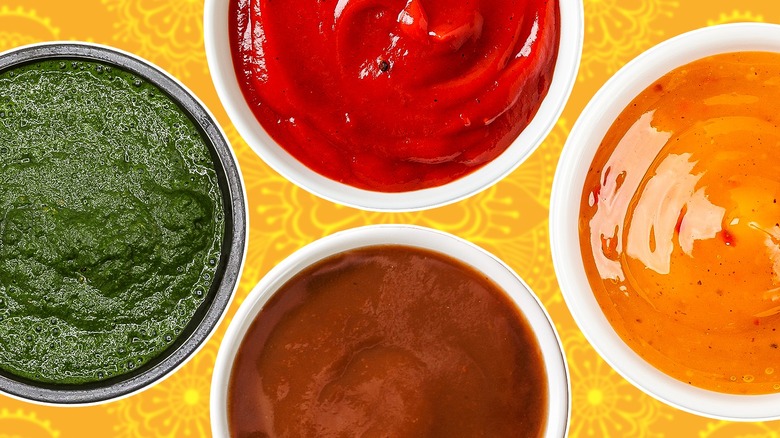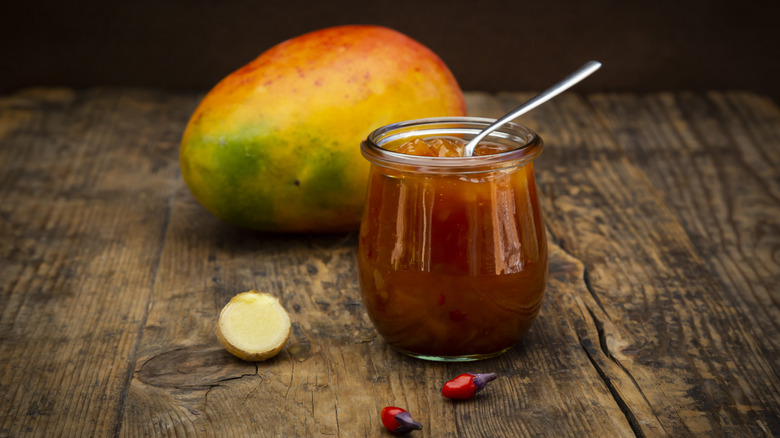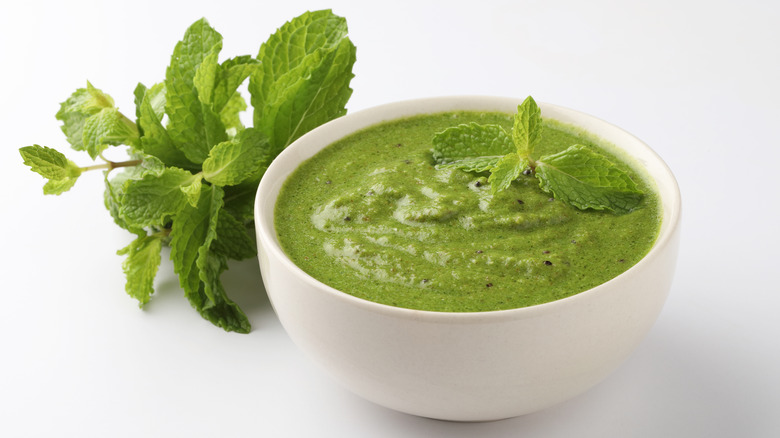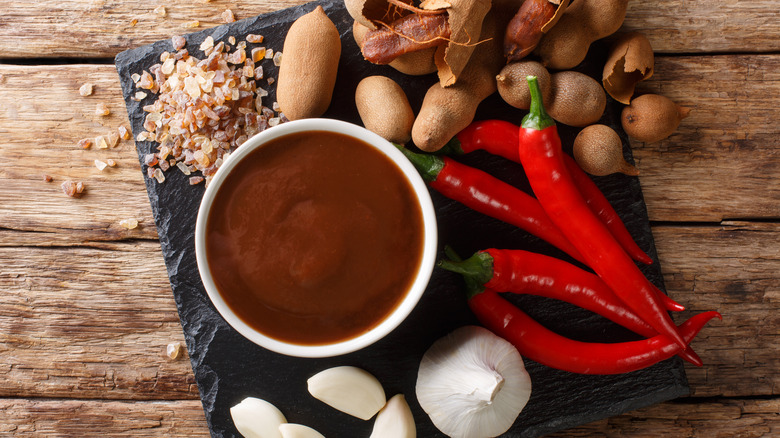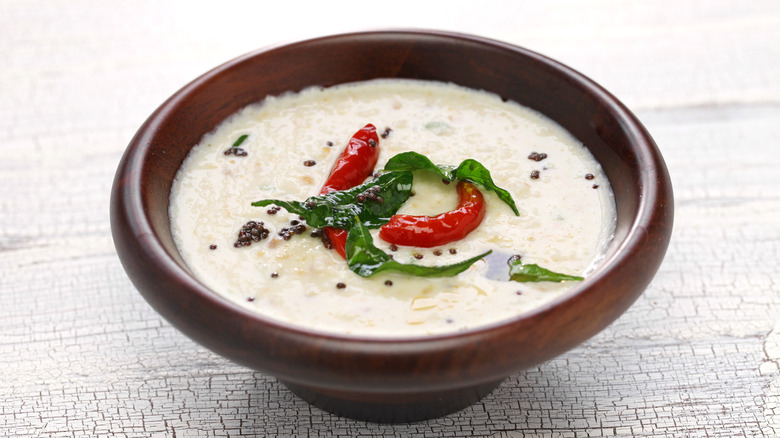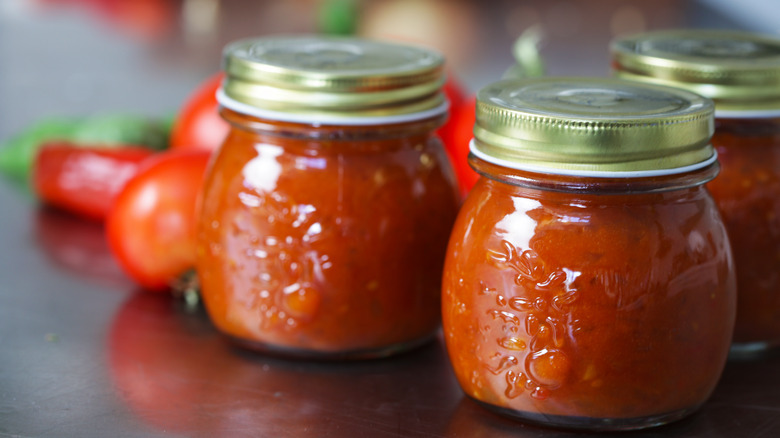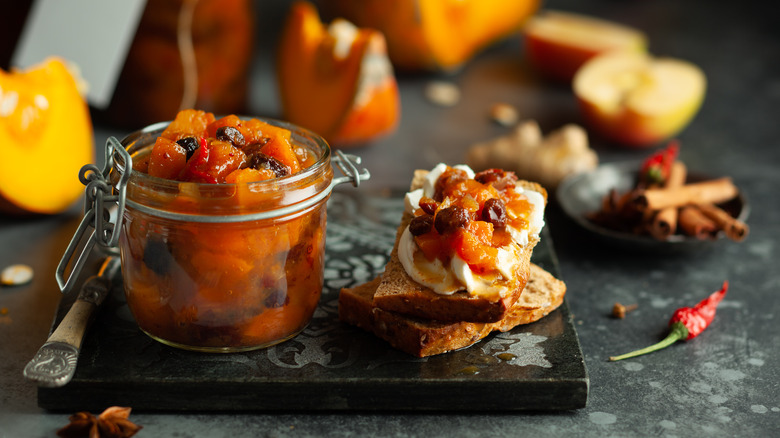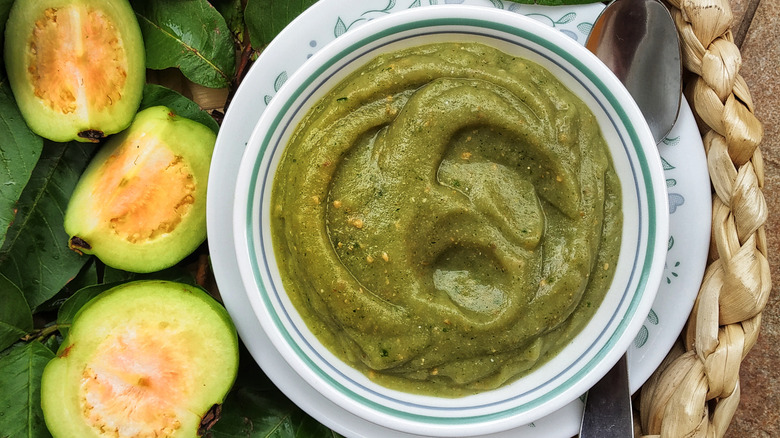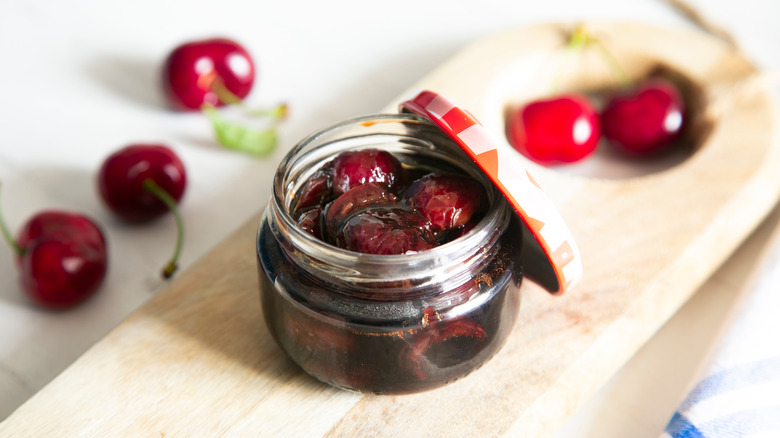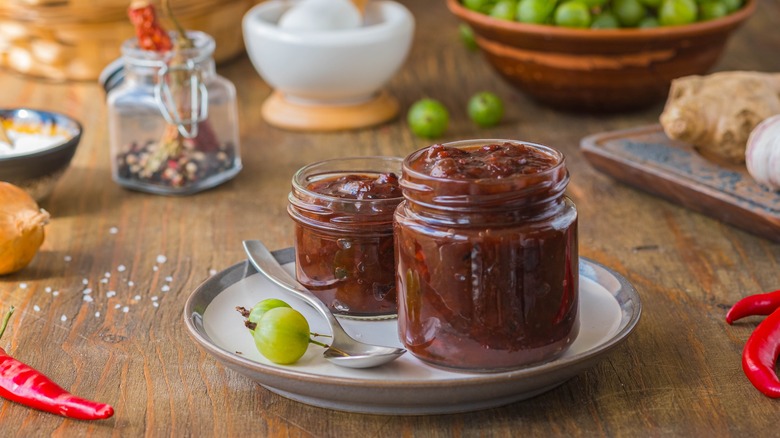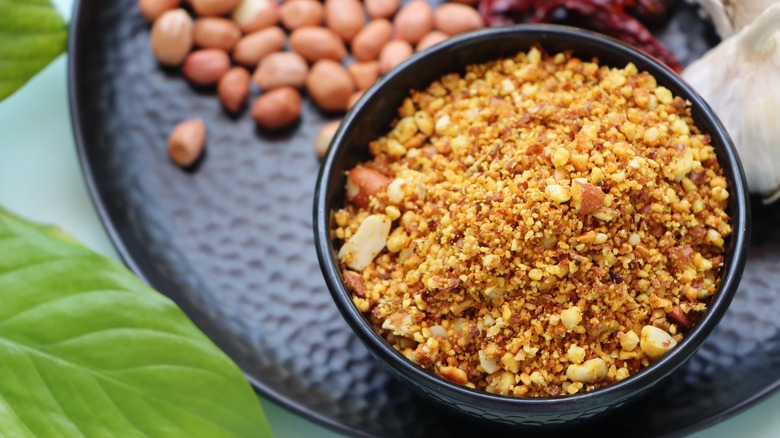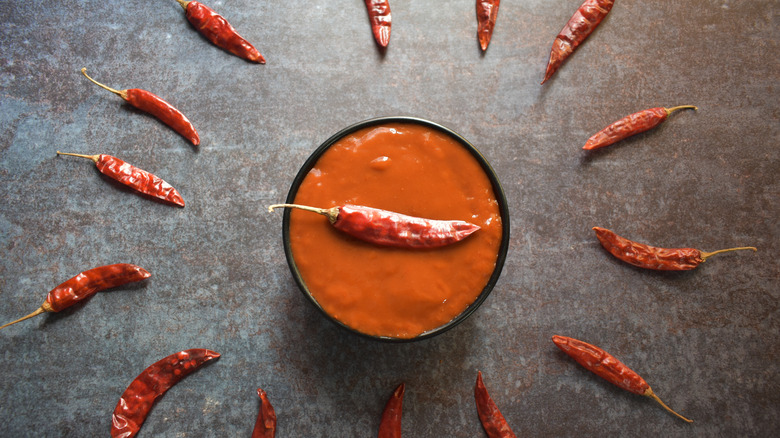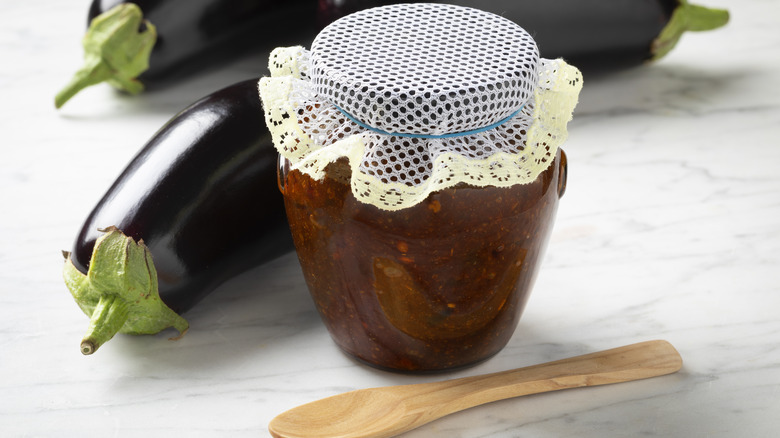12 Types Of Chutney And How To Use Them
Chutneys are an indispensable component of Indian cuisine — so much so that my Indian husband believes any meal without chutney is incomplete. Served alongside everything from rice to dosa to vegetable fritters, recipes frequently call for unripe produce; in other words, the condiment is also a way to make the most of what nature has to offer (and extend the seasonal window for certain ingredients).
Now, if you're making homemade chutney, your best bet is to look for specialty ingredients at an Indian grocery. You can also find premade chutneys at these stores, as well as in the international aisle of larger supermarkets, and certain Indian restaurants. Of course, since pairing a chutney with the right meal is "like having a perfect watch for the perfect suit" (per my husband's eloquent description), it's worth knowing the specifics of various types of chutney.
Given my experience living and traveling in India since 2019, I'm well-acquainted with this beloved Indian condiment, as well as common ingredients and dish pairings for the many varieties. Whether you love Indian food, want to level up your sandwich game, or are searching for a unique ingredient to add to your charcuterie board, here are 12 types of chutney and how to use them.
Mango chutney
Mango chutney is a mouthwatering condiment to serve alongside pakoras, poppadoms, and spicy curries. It's great atop salads, too, though you can use it anywhere you might use mango salsa (such as stuffing your quesadilla with it for a fusion twist). However, there are several kinds of mango chutney that you should know about before digging in — mainly related to whether the recipe uses unripe, semi-ripe, or just-ripe mangoes.
Unripe mangoes result in sour and tangy chutneys, while ripe mangoes make sweeter chutneys that are great alongside spicy dishes. If you like heat — or if you need to make a bland dish more exciting — consider opting for a spicy mango chutney that uses red chile peppers. Other common ingredients in mango chutney include vinegar, sugar or jaggery, raisins, ginger, onion, and spices (like cinnamon and cloves).
The type of mango in your chutney also matters. In the United States, we have easy access to several varieties of Central and South American mangoes, including Ataulfo, Tommy Atkins, Kent, Keitt, Francis, and Haden. These varieties peak at different times of the year, and because each mango has a distinct flavor and texture, you might notice subtle differences in a homemade mango chutney depending on when you make it.
Green chutney
In any green chutney recipe, you're likely to find cilantro, ginger, green chile peppers, and an array of spices. Mint is a common addition, as well, favored for its cooling properties. Now, if you prefer thicker chutney (the ideal texture for sandwiches), you might want to include ingredients like peanuts, roasted chana dal (split chickpeas), coconut, and yogurt. Meanwhile, a thinner green chutney can function as a piquant salad dressing or marinade for ingredients like tofu and paneer.
No matter the style, green chutney has a relatively short shelf life in my experience (at least compared to the other chutneys on this list) due to how quickly fresh cilantro spoils. Given this, you shouldn't hesitate to tap into the flavors of green chutney when cooking other cuisines; it can be the perfect accompaniment for barbecued or grilled lamb, for instance. You can also adjust your recipe to mimic the spicy Middle Eastern variation known as zhoug, which uses olive oil and parsley, and is commonly served with hummus and falafel.
Tamarind chutney
Frankly, it's high time that we Americans stop overlooking tamarind and learn how to use it. A prevalent ingredient in Africa, Asia, and Latin America, tamarind tastes somewhat like sour cherries or apricots when ripe. Consequently, tamarind chutney is sweet, tangy, slightly sour, and often used in combination with yogurt for chaat (Indian street food). From kachoris to dahi vadas to samosas, tamarind (or imli) chutney helps balance out the savory and spicy flavors of other ingredients like lentils, potatoes, and green chutney.
To make this chutney at home, you'll need tamarind paste or concentrate (made from tamarind pulp). You can usually find at least one of those two items in a well-stocked supermarket. Additionally, when making tamarind chutney, you should consider preparing a large batch. After all, tamarind chutney is safe to store for up to two months in the refrigerator.
It's also worthwhile to source asafoetida powder when making tamarind chutney. This adds a wonderfully pungent dimension to complement the tamarind, jaggery, and dates (which are often included for additional sweetness). Keep in mind, though, that asafoetida — which is the dried sap of an herb called ferula – isn't always suitable for anyone who's gluten-sensitive because it's frequently processed with wheat flour. On that note, there are gluten-free asafoetida powders available, so feel free to source according to your personal dietary needs.
Coconut chutney
Coconut chutney is a cooling condiment that's served alongside most South Indian meals, and considered essential for eating dosas, vada, and idlis. It's usually seasoned with ingredients like black mustard seeds, curry leaves, fresh ginger, garlic, green chiles, plus a dash of tamarind. A common variation of coconut chutney also incorporates cilantro for a more savory flavor profile. Additionally, it's not unusual to find roasted chana dal or urad dal (black lentils) served on top, while raw green mango is another unique and tasty addition that's not as common in the U.S.
There are several options when it comes to the form of coconut you can use. Freshly grated coconut meat is traditional and can usually be found in the frozen aisle of Asian groceries. It's also possible to use dried, shredded coconut — but in my experience, it then becomes more difficult to blend the ingredients into a smooth sauce. Then again, some recipes call for yogurt, which you can use in combination with warm water to soak dried coconut ahead of time (about 15 minutes or so should do the trick).
Tomato chutney
Move over, ketchup: tomato chutney is the next condiment you'll want to add to your burgers and sandwiches. This type of chutney comes in several variations, including South Indian and Bengali style preparations that can be made with or without yogurt. The ingredients required for tomato chutney vary by recipe, but you can generally expect to find garlic, ginger, red chiles, mustard seeds, turmeric, curry leaves, and asafoetida.
If you're making tomato chutney at home, you have the freedom to adjust spice levels according to your preferences (and according to the dish you plan to serve it with). For instance, you may want to include more spice if eating it alongside a bland dish such as plain idli, while less spice should be used if pairing it with a dish like Mysore masala dosa (which already features hot red chutney). Other common pairings include fish, dosa, and pakora. You can even add it to yogurt for a quick version of raita.
Additionally, don't waste your money using heirloom tomatoes for this type of chutney. For that matter, you should avoid using any type of sweet tomato, as well. Indian cuisine capitalizes on tomatoes' tanginess and umami flavors, after all — two elements that are certainly highlighted in tomato chutney.
Raisin chutney
If you're in the mood for chutney but don't have any fresh fruits or herbs on hand, raisin chutney should be next on the menu. This chutney has many internationally inspired variations, making it suitable for a wide range of dishes. Frequently, the raisins are soaked in water ahead of time to increase their juiciness, after which they may or may not be blended into a smooth sauce.
Because of the countless modifications you can make to this chutney, it offers a great opportunity to get creative in the kitchen, adjusting recipes based on personal preferences and the type of cuisine. For example, our smoked whitefish sandwich with curry aioli and raisin chutney uses red raisins alongside orange juice, sugar, red wine vinegar, fresh ginger, and orange peel. Other recipes call for apples, tamarind paste, balsamic vinegar, honey, white raisins (instead of red), and even parsley.
Raisin chutney is sweet and often features familiar flavors. With that in mind, it would be a smart and chic addition to your next charcuterie board alongside goat cheese, walnuts, and almonds (among other foods). Raisin chutney would also go well in curried chicken salad wraps, alongside korma, or anywhere you might use tamarind chutney.
Guava chutney
Fresh guavas may not be a mainstay in most American grocery stores, but they can often be found in Indian stores or larger international supermarkets. Guavas boast an impressive nutritional profile, and have a unique, mouthwatering flavor to boot. One taste of the fruit and it becomes clear why it's ideal for chutney: Guavas are naturally sweet yet tangy, especially when they're either semi-ripe or just ripe.
In India, guava chutney (otherwise known as amrood ki chutney) frequently includes some combination of onion, garlic, tamarind, cilantro, cumin, ginger, chiles, and/or mint. Some recipes call for roasting the guava, which lends the chutney a hint of smokiness and caramelized flavor. Roasting is typically done on a gas stove, which many Indian households possess, but it can also be accomplished with a grill or in the oven if needed.
Guava chutney can be enjoyed as a dip for chips, a filling for sandwiches, or a condiment for pakoras. Additionally, guava made our list of the best fruit and cheese pairings, so consider trying guava chutney on grilled cheese sandwiches or with cheddar cheese and crackers. It may not be the most common kind of chutney, but it will undoubtedly leave an impression on whoever is lucky enough to taste it.
Cherry chutney
Though cherries in India are primarily grown in the Himalayan region known as the Kashmir Valley, they're shipped and enjoyed all over the country. However, cherry season lasts only two months (from May until July), and frozen cherries aren't widely available. As a result, my friends in India usually make cherry jams and chutneys while they're still fresh to enjoy the fruit's flavors year-round.
Now, while some of the chutneys on this list require you to go out of your way to find ingredients, cherry chutney is not one of them. In fact, you can even make this chutney with frozen cherries — and bypass the time commitment of pitting each fruit in the process. That being said, you'd miss out on the subtle almond flavor that can be obtained by simmering cherries with their pits (which are later removed).
Regardless of the cherries you use, this chutney is another great charcuterie board addition. Cherries have a natural affinity for cheeses, such as goat cheese and Brie, as well as nuts, like pistachios, walnuts, and almonds. If you need a recipe to get started, try our smoked turkey and cherry chutney panini. The chutney calls for brown onion, brown sugar, apple cider vinegar, and fresh ginger, and can be stored in your refrigerator for up to a week once prepared.
Gooseberry chutney
It's time to get acquainted with the humble gooseberry. This small, grape-like fruit is valued for its high fiber and vitamin C content as well as its unique flavor. Gooseberries are sometimes sweet, sometimes tart, and sometimes even bitter. In fact, Indian gooseberries tend to be more bitter than the sweeter varieties found in Europe or the more tart American varieties.
Of course, you probably won't have the privilege of being picky, since gooseberries aren't common in many U.S. grocery stores. You might have more luck finding them in the frozen aisle of an Indian grocery store, but because they're a bit rare, be prepared to pay more than you usually would for other frozen fruits. No matter how sweet, bitter, or tart your gooseberries are, you can make them compatible with the other ingredients in your chutney by making minor adjustments (for instance, by adding more or less sugar).
Indeed, with ingredients like vinegar, coriander, cilantro, coconut, and black salt, you can use gooseberries to make chutney that's the perfect balance of sweet and tart. Amla chutney (as it's known in India) is usually paired with South Indian dishes like curd rice, pongal, idli, and dosa, but you can also serve it alongside cheese, on sandwiches, with crackers, or as a sauce for meats.
Peanut chutney
Peanut chutney is a versatile condiment. It pairs well with South Indian breakfast items like upma, idli, dosa, and pesarattu (mung bean pancakes), along with rice, pakora, and appam (fermented rice and coconut milk pancakes). Often featuring other ingredients such as tamarind, cumin, garlic, curry leaves, green or red chile peppers, tomatoes, and coconut, peanut chutney is like the savory version of peanut butter you're imagining.
Interestingly enough, peanut chutney isn't always served as a sauce. It can also be enjoyed as a dry powder, which is then sprinkled over dishes for a burst of flavor. Additionally, you don't need to refrigerate this type as you would other chutneys. Wet peanut chutney retains its texture and does not spoil quickly – even when left at room temperature — so it's a safe option to pack for road trips or lunch on the go. You can purchase an instant peanut chutney powder that simply needs to be mixed with water, as well, which is a great option for camping and backpacking.
Red chutney
This list wouldn't be complete without red chutney. An essential component of many dosas, including the world-famous Mysore masala dosa, be forewarned: red chutney is spicy, and it is addicting. As the name suggests, this condiment is red in color, owing to the fact that it uses plenty of dried red chile peppers. Other common ingredients in red chutney include garlic, tamarind, cumin, coconut, and roasted Bengal gram.
When layered in dosas alongside a heap of mildly spiced mashed potatoes, red chutney is divine. But it can also be served with idli and uttapam, as well as in sandwiches and wraps. If you're sensitive to heat, try pairing it with plain or cooling ingredients, such as coconut rice or curd rice.
Additionally, note that red chutney shouldn't be confused with tomato chutney. They have two very different flavor profiles, after all. Red chutney is extremely bold, while the nuanced flavors of tomato chutney can be better appreciated since they're not overwhelmed by spiciness.
Eggplant chutney
If you've ever eaten eggplant before in Indian cuisine, odds are it was in the form of either: baingan bharta (a smoky, oniony, and tomato-forward North Indian dish), or sambhar (a thin, tangy, and spicy South Indian stew served alongside idli, dosa, vada, and rice). However, eggplant also makes for a great chutney option when it's been roasted and seasoned with ingredients such as mustard seeds, curry leaves, and chile peppers.
Eggplant chutney is a common condiment in the Indian state of Andhra Pradesh, so try pairing it with other regional specialties like mustard and tamarind cabbage, or green beans with coconut. It also tastes wonderful alongside hummus and bell peppers in a sandwich or on crackers with cheese. Be sure to use the freshest eggplants possible and remove their seeds to avoid excess bitterness. Personally, I enjoy adding tamarind and/or roasted cumin seeds when making eggplant chutney from scratch.
